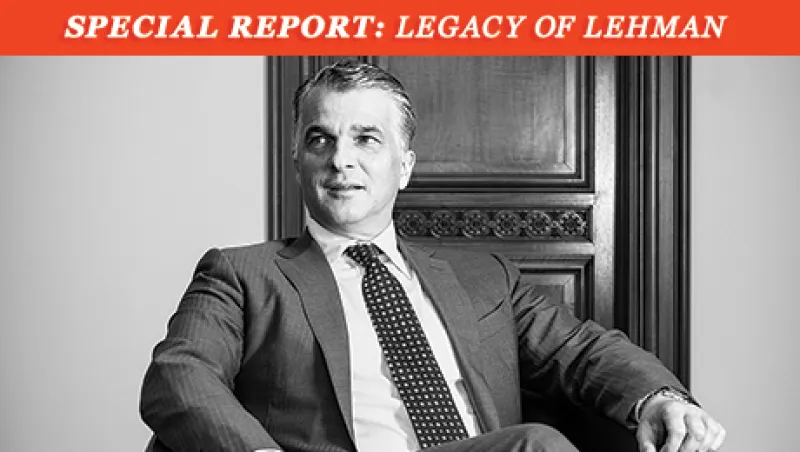When Lehman Brothers Holdings collapsed, European officials reacted with barely concealed outrage at their American counterparts. By letting the investment bank go bust, they contended, the U.S. threatened to unleash a contagion that could crash the global economy. "For the equilibrium of the world financial system, this was a genuine error," Christine Lagarde, then the French Finance minister, said at the time.
Today, Europeans have no one to blame but themselves for their problems. Although the crisis had its origins in the U.S. banking system, the fallout has been far greater in Europe, where the region's undercapitalized banks buckled badly and are still far from healthy. Ireland's banking failures virtually bankrupted the state; Spain needed a €100 billion ($133 billion) bailout to prop up its cajas, or savings banks, after an epic property collapse; two of the U.K.'s Big Four banks remain nationalized; and even the region's healthier banks are still held hostage by the euro area's debt crisis. Five years after Lehman it's the European banking system that poses arguably the greatest risk to global financial stability. (See also "Ireland's Banks Take the First Step on Long Road to Recovery")

Deutsche Bank's Jain (top) and Barclays' Jenkins are raising capital. (Photographs by Munshi Ahmed/Bloomberg, top, and Matthew Lloyd/Bloomberg) |
"Too much emphasis has been placed on the hope of the European economy recovering and not enough on banks' tackling their individual problems," says Sergio Ermotti, chief executive officer of UBS, which has taken some of the most drastic action to downsize, to meet Switzerland's rigorous regulatory standards.
Banks in Europe have reduced their balance sheets by a total of €2.4 trillion since 2011. They have been slower to raise capital, although recent moves by Barclays and Deutsche Bank — which raised £5.8 billion ($9.1 billion) and €2.96 billion, respectively, with share issues — suggest that more banks may begin to move on this front.
"European banks are not even half way to becoming sustainable," Alberto Gallo, head of European macro credit research at Royal Bank of Scotland Group, wrote in a July 17 note to clients. Gallo reckons that the region's banks need to shed a further €2.7 trillion in assets to meet the tighter capital and leverage ratios that regulators have imposed in the wake of the crisis. They will also need to raise a lot more capital: Gallo estimates the capital requirements of the 13 largest European banks at some €60 billion.
The Legacy of Lehman: A Look at the World 5 Years After the Financial Crisis
- 5 Years After Lehman, No One Can Declare the Financial System Safe
- As the Fed Readies to Taper, Is the World Ready for Higher U.S. Rates?
- Emerging Markets Face Mounting Challenges as Global Liquidity Dries Up
- China Exploits Crisis, Positions Renminbi as Potential Rival to Dollar
The need for restructuring will be challenging for an industry that's struggling to regain its health. Pretax earnings at European banks rose by an average of just 3.7 percent in the second quarter from the same period a year earlier, compared with a 28.9 percent rise at U.S. lenders, according to StarMine, an equity analytics arm of Thomson Reuters. Many European bank stocks continue to trade at a discount to book value, whereas U.S. banks trade at a premium, on average, according to Thomson Reuters Datastream. "The discount to book value shows that investors don't put too much faith in banks' financial statements," says Nicolas Veron, visiting fellow at the Peter G. Peterson Institute for International Economics in Washington.
The restructuring, in turn, threatens to act as a brake on Europe's feeble economic recovery. Aggregate bank lending to nonfinancial companies in the euro area fell by 8.5 percent between its January 2009 peak and July of this year, to €4.4 trillion, according to the ECB. The vicious circle between weak banks and weak economies has been a defining feature of Europe's debt crisis, making economic recovery — and banking reform — all the harder to achieve. "Since May 2012 banks in Europe have cut lending to nonfinancial companies by €250 billion," RBS's Gallo tells Institutional Investor. "This will continue as banks try to recapitalize and meet stricter regulations." (See also "Europe Looks to Impose New Curbs on Universal Banks")
"Banks may need more capital, they may need to be safer, but they also need to operate in an economy that is competitive," UBS's Ermotti says. "The financial system can only be as strong as the economy it operates in. Capital and liquidity rules combined with the timing of implementation make it difficult for them to support the economy."
Ultimately, Europe needs a proper banking union to stabilize the industry and restore growth. By strengthening supervision, establishing a mechanism for resolving failed banks and creating a common EU financial backstop for the industry, such a union would break the link between indebted sovereigns and weak banks that is at the heart of the European crisis. But one year after EU leaders declared this as their top goal, opposition in Germany and other states is stalling progress.
EUROPE'S BANKS HAVE COME A LONG WAY from the dark days of 2008, but much of the sector's recovery to date reflects official intervention rather than efforts by the banks themselves.
After Lehman's collapse governments across Europe commited more than €1.5 trillion in guarantees and capital injections to prop up the sector. The U.K. government was left holding 84 percent of RBS and 43.4 percent of Lloyds Banking Group, which had taken over a flailing HBOS. Germany's Hypo Real Estate Holding and Franco-Belgian lender Dexia collapsed, requiring costly interventions by all three governments. The Dutch government spent €10 billion to bail out ING Group and oversaw a drastic reduction in the company's scope, including the sale of its insurance operations.
As the financial crisis transformed into the European sovereign debt crisis, the European Central Bank responded in late 2011 and early 2012 by injecting €1 trillion of liquidity into the banking system through its long-term refinancing operations. And when speculation about a euro breakup hit a fever pitch in the summer of 2012, the ECB promised to buy the debt of troubled economies through its new outright monetary transactions program. These actions calmed markets, saved the euro and stemmed a flight of bank deposits from peripheral countries, but they haven't been a panacea.
"LTRO and other measures have helped the European banking sector, but the fact they are necessary is a function of limited confidence in the sector," says Kian Abouhossein, banking analyst at J.P. Morgan in London. "This limited confidence is down to the steps European banks did not take in 2008 — they didn't deal with their legacy assets, and they didn't raise capital in sufficient quantities."
Banks now need to make up for lost time. As it prepares to take over as Europe's chief banking supervisor next year under an overhaul of EU financial regulation, the ECB will require banks to undergo asset quality reviews. The central bank wants to make sure that lending institutions meet the EU's strict new standards for capital and leverage and aren't hiding dud assets on their books. It is determined to avoid the mistakes of two previous stress tests, conducted by the London-based European Banking Authority in 2011 and 2012, that were largely dismissed by market participants as too lenient.
"It's hard to say how much of a systemic risk is posed by the European banking sector, because there is still a lack of transparency, and that creates uncertainty," says the Peterson Institute's Veron. "There remains significant fragility in the system. We need a comprehensive public assessment of bank balance sheets."
National regulators have already begun stepping up pressure on banks to meet the new standards. Under an EU directive that implements the global banking capital standards known as Basel III, European banks must hold tier-1 capital of 7 percent of risk-weighted assets, up from 4 percent previously. In addition, banks will have to meet a new leverage ratio that requires them to hold equity capital equal to 3 percent of total assets. Banks have until 2018 to meet the target, but investors and regulators have been pushing them to do so earlier. For European banks that have used risk weightings aggressively in the past to reduce their capital needs, the introduction of a blunt tool like the leverage ratio will hit hard.
Other regulations may be looming. The so-called Vickers Commission in the U.K. has recommended that banks ring-fence their retail operations from their investment banking divisions to contain risks, while the EU's Liikanen report has called for them to separate their proprietary trading and other high-risk activities from mainstream banking operations.
Banks are responding to the tougher environment. On July 30, Barclays CEO Antony Jenkins bowed to pressure from regulators and announced plans for a major equity-raising exercise. The bank will raise £5.8 billion with a rights issue of new shares, sell some £2 billion worth of contingent capital securities and pare assets by as much as £80 billion, largely by shrinking its derivatives book and reducing securities financing activities. The move followed a determination by the Prudential Regulatory Authority, the arm of the Bank of England that supervises banks, that Barclays needed an additional £12.8 billion of capital to meet the new leverage ratio. (See also "Barclays Capital's Bob Diamond: Wall Street's Would-Be King")
Also in late July, Germany's Deutsche Bank announced steps to bolster its capital ratios. The bank will cut its balance sheet by €250 billion over the next two years, mainly by netting down its large derivatives exposure. Those reductions, combined with the proceeds of a €2.96 billion share sale in April, should allow Deutsche to meet the new leverage rule and achieve its tier-1 capital ratio target of 10 percent. Anshu Jain, the bank's co-CEO, said Deutsche's "hunger march" for capital was over. (See also "The Last Hurrah for Deutsche Bank CEO Josef Ackermann")
Swiss banks have taken more-radical steps, reflecting the Swiss National Bank's demand that Credit Suisse and UBS hold a capital cushion of 3 percent of risk-weighted assets on top of the Basel III standard of 7 percent.
UBS, which needed a government bailout in 2008 after taking write-downs of more than $50 billion on subprime mortgages and other toxic assets, has slashed its risk-weighted assets by 40 percent since September 2011, to Sf239 billion ($258 billion). It has scaled back its investment banking unit; shut a number of capital-intensive businesses, such as distressed-debt trading and sovereign bond trading; and refocused the group around wealth management and Swiss retail and commercial banking. The efforts seem to be working. In August the SNB said the stabilization fund it set up in 2008 to purchase $38.7 billion in troubled assets from UBS had repaid its loan to the central bank, allowing UBS to proceed with its plan to repurchase those once-toxic assets.
Ermotti, the fourth CEO to run the bank since the crisis erupted, says the change in strategy is profound: "Shortly after I became CEO [in September 2011], we made an assessment that despite years of investment, the investment bank had not delivered the results we were looking for. We recognized that the regulatory environment had changed for good." The bank's net income rose 32 percent in the second quarter, to Sf690 million, despite an $885 million write-off to settle charges that UBS misrepresented mortgage-backed securities it sold to Fannie Mae and Freddie Mac.
French banks have taken big steps to delever since 2011, when concerns about the euro zone debt problems sparked a flight of capital by U.S. money market funds, which had been big buyers of French bank paper. The sudden drop in funding forced French banks to reduce their U.S. activities, shrink lending and shift their investment banking models from holding loans on their balance sheets to distributing risk to third-party investors. On August 1, Frederic Oudea, chairman and chief executive of Societe Generale, said the country's second-biggest lender was on course to meet regulatory requirements without having to reduce assets further. BNP Paribas, one of the most strongly capitalized banks in Europe, reported a 3.4 percent leverage ratio at the end of June.
The real risks lie in the periphery of the euro zone and in midtier banks. The latter don't get anywhere near as much attention as the big banks but account for 67 percent of European banking assets, according to estimates by the ECB. Europe's smaller banks "are less able to raise capital, so deleveraging is the only option," says RBS's Gallo.
In June the U.K.'s Co-operative Bank acknowledged that it had to plug a £1.5 billion hole in its balance sheet. In February the Netherlands nationalized bank and insurance group SNS Reaal in a €10 billion deal after a failed attempt by private investors to rescue the bank, which has suffered heavy property loan losses. The move marked the first use of the country's Intervention Act, a law passed in 2012 to comply with EU rules requiring countries to have a legislative framework for resolving failed banks. As part of the deal, the government decided to impose losses on both shareholders and subordinated creditors through investor bail-ins. On June 18, Danske Bank said it had been ordered by the Danish Financial Supervisory Authority to change how it calculates its solvency and to set aside more risk capital. Danske, Denmark's biggest financial institution, said the order would increase its risk-weighted assets by about 100 billion Danish kroner ($17.9 billion) from the first-quarter level of Dkr797 billion. J.P. Morgan's Abouhossein says the Danish move is part of a broader trend by European regulators to apply Basel III's tougher standards in the calculation of risk-weighted assets, which he estimates will raise capital requirements on banks by about half a percentage point.
Meanwhile, the European Commission is still deciding on a restructuring plan for Banca Monte dei Paschi di Siena, Italy's third-largest lender, which asked for a €4 billion state bailout in 2012 following losses on derivatives transactions made in 2008–'09. "The bank will either require more public support or have to implement burden-sharing on subordinated debt," says RBS's Gallo.
In the euro zone periphery, sovereign bailouts have triggered austerity and recession, complicating the task of restoring banks to health. Spain's banks have been forced to restructure as part of a €100 billion EU rescue package agreed to in June 2012. Under the restructuring plans Bankia, the country's third-largest lender, and three other banks — Banco de Valencia, Catalunya Banc and NCG Banco, which received €37 billion of cash among them — will force losses on junior creditors by haircutting the nominal amount owed and swapping the remaining amount for equity. This burden-sharing will reduce the total amount of capital injected into the banks by the Spanish government by €10 billion, according to the European Commission.
"The Spanish banking sector has already carried out much of the adjustment it needed, both in terms of the nationalized banks and on the part of others like Santander, which have not received any support at all," says Jose Antonio Alvarez, chief financial officer of Banco Santander. "The sector has already made provisions and increased capital by an amount equivalent to 25 percent of GDP, which looks like more than enough." Santander posted a 29 percent jump in its first-half earnings, to €2.25 billion, and said its tier-1 capital ratio would be more than 9 percent under Basel III rules. "Capital is probably the most positive area of [the] results, which would probably relieve some pressures around the bank's need to raise equity," analysts at Credit Suisse said in a note to clients.
The Spanish experience is evidence of the fragmented approach to banking resolution and a strong argument for completing Europe's much-discussed banking union, which would harmonize regulation and provide a common backstop to the industry. Progress is proving fitful and slow, however.
In June, EU finance ministers agreed on common rules that would force creditors to take bigger losses in cases of bank failures, but these rules won't come into force until 2018. In July the European Commission unveiled its proposal for a single resolution mechanism for winding up failed banks. The plan would involve national regulators but give the Brussels-based commission, the EU's executive agency, the power to decide when to resolve a bank. For politicians in Germany and France, allowing an EU bureaucrat to shut down a national bank is anathema, setting up a major political struggle this fall. Meanwhile, the idea of having a common backstop to provide future bailouts — a central plank of banking union when plans were first floated a year ago — has quietly been dropped in the face of opposition from a bailout-fatigued Berlin.
European banking union will be essential to restoring the industry to full health, but that is a difficult political project that will take years to achieve. Bankers, investors and regulators had best hope it doesn't take another big bank crisis to reach that goal.
The Legacy of Lehman: A Look at the World 5 Years After the Financial Crisis
- 5 Years After Lehman, No One Can Declare the Financial System Safe
- As the Fed Readies to Taper, Is the World Ready for Higher U.S. Rates?
- Emerging Markets Face Mounting Challenges as Global Liquidity Dries Up
- China Exploits Crisis, Positions Renminbi as Potential Rival to Dollar






